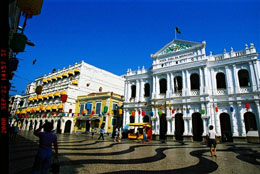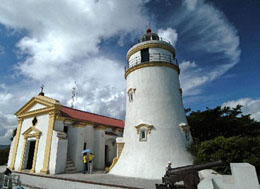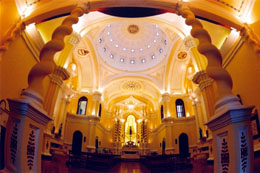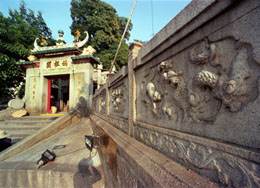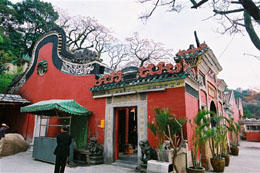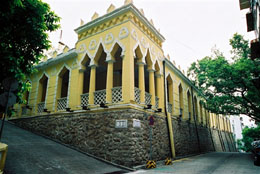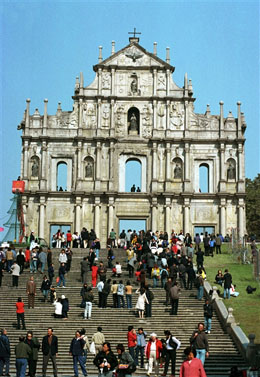"The Historic Center of Macao" is the product of over 400 years of cultural exchange between the western world and Chinese civilization. The architectural heritage, predominantly European in nature, stands in the midst of traditional Chinese architecture in the historic settlement, providing contrast. It is the oldest, the most complete and consolidated array of European architectural legacy standing intact on Chinese territory.
The settlement of Macao by Portuguese navigators, in the mid-16th century laid the basis for nearly five centuries of uninterrupted contact between East and West. The origins of Macao’s development into an international trading port make it the single most consistent example of cultural interchange between Europe and Asia. “The Historic Center of Macao” coincides with the heart of the western settlement area, also known as the “Christian City” in history.
The emergence of Macao with its dual function as a gateway into China, and as China's window onto the world, reflected a relaxation of certain restrictions combined with a degree of open-mindedness that offered a creative way to supplement China's vassal-state trading system and marked a turning point in the history of both China and Europe.
People of different nationalities came, bringing their own cultural traditions and professions, permeating the life of the city as can been seen in both intangible and tangible influences. Since the mid-16th century, Macao has developed a visible dual culture which continues even now, and this cultural accommodation is seen in the city's history, administrative structures, as well as in physical features like architecture, gardens and public spaces.
"The Historic Center of Macao" is a living representation of the city's historic settlement, encompassing architectural legacies interwoven in the midst of the original urban fabric that includes streetscapes and piazzas, such as Barra Square, Lilau Square, St. Augustine's Square, Senado Square, Cathedral Square, St. Dominic's Square, Company of Jesus Square and Camoes Square.
These major urban squares and streetscapes provide the linkage for a succession of over 20 monuments, including A-Ma Temple, Moorish Barracks, Mandarin's House, St. Lawrence's Church, St. Joseph's Seminary and Church, Dom Pedro V Theatre, Sir Robert Ho Tung Library, St. Augustine's Church, "Leal Senado" Building, Sam Kai Vui Kun Temple, Holy House of Mercy, Cathedral, Lou Kau Mansion, St. Dominic's Church, Ruins of St. Paul's, Na Tcha Temple, Section of the Old City Walls, Mount Fortress, St. Anthony's Church, Casa Garden, the Protestant Cemetery and Guia Fortress (including Guia Chapel and Lighthouse).
On July 15, 2005, the site was inscribed on the World Heritage List as a cultural property at the 29th session of the UNESCO's World Heritage Committee.
Strolling through "The Historic Center of Macao"
Ma Temple is located on the southwestern tip of the Macao Peninsula overlooking Barra Square and the seashore. Around the corner of A-Ma Temple is the Moorish Barracks situated on Barra Street. Further up the road, the narrow street suddenly opens onto Lilau Square, the first residential district of the Portuguese settlers in history where the Mandarin’s House is just tucked behind the pastel façades across the street. Further up the road, Barra Street connects into Padre António Street and Lourenço Street where St. Lawrence’s Church stands. Behind the church, Prata Street leads to the junction of São José Street where the grand entrance to St. Joseph’s Seminary and Church is located.
Walking alongside the granite wall on Prata Street and the adjoining Seminário Street, one arrives at the junction of Gamboa Lane. Climbing up the hill from there, the path leads to St. Augustine’s Square enclosed by a cluster of monuments – St. Augustine’s Church, Sir Robert Ho Tung Library and Dom Pedro V Theatre.
Moving down Tronco Velho Lane to Almeida Ribeiro Avenue, the narrow streetscape opens onto the main city square – Senado Square. Situated at one end, the “Leal Senado” Building has a commanding view overlooking the entire square, flanked on both sides by South European-style buildings with the glimmering white façade of the Holy House of Mercy standing in its midst. Tucked behind the commercial shop fronts to the left of the Leal Senado Building is the Sam Kai Vui Kun Temple.
Climbing up the slope alongside the Holy House of Mercy, one eventually lands at Cathedral Square on the hilltop where the Cathedral is located. Turning back down to St. Dominic’s Square, one passes a typical Chinese courtyard house compound – the Lou Kau Mansion. St. Dominic’s Church is located at the junction of Senado Square and Dominic’s Square.
Ascending from the base of Mount Hill from this urban piazza along Palha Street, the bluestone cobbled road leads to the grand façade of the Ruins of St. Paul’s, with Mount Fortress to the side of it. Behind the majestic church front, is the miniature Na Tcha Temple and Section of the Old City Walls. Further down the hill, the linear route ends at St. Anthony’s Church, the Casa Garden and the Protestant Cemetery. Standing on the highest hill of Macao Guia Hill, Guia Fortress, Chapel and Lighthouse are visible along the skyline of the peninsula.
Cultural Affairs Bureau of the Macao Special Administrative Region Government
Tel: 853-5993137 5993162
Sources: Cultural Affairs Bureau of the Macao SAR Government
(China.org.cn)

